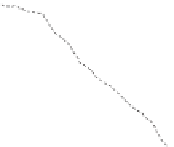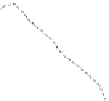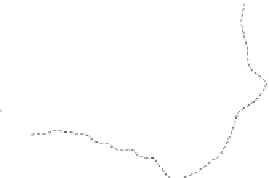Geoscience Reference
In-Depth Information
Figure 2.3 Interpolated surface of variation in earthquake hypocentral depths across the Australian
continent constructed using the ARCGIS Point Statistics tool (plotted value is the mean of values
within a moving 3 degree search box, output cell size 0.25 degrees). Events with a catalogued depth of
greater than 50 km are not considered. The earthquake catalogue used is fromAllen
et al
.(
2012a
)
, and
does not filter according to hypocentral uncertainty (cf. Leonard,
2008
)
. Higher seismicity zones are
shown (cf.
Figure 2.1
)
. Locations referred to in text are marked. Significant earthquakes mentioned in
text are indicated by numbers: 1, Uluru; 2, Banda Sea. Note the greater depth of events in the FRSZ
and NWSSZ compared to the SWSZ and SESZ.
diford and Egholm,
2008
)
, the Northwest Shelf Seismic Zone (NWSSZ -
Figure 2.1
)
is
characterized by extremely poorly constrained hypocentres, with depth uncertainties typ-
earthquake hypocentres tend to be deeper in this region of extended continental crust than
in the adjoining non-extended cratonic crust (
Figure 2.2
)
. Approximately 40% of events
recorded in the NWSSZ occur at depths greater than 10 km.
The FRSZ in South Australia consistently produces deeper earthquakes than other parts
of the continent (
Figure 2.3
)
, with over 75% of well-constrained events occurring at depths
December 2003) suggested spatial variation in the depth distribution, with a predominance














































































































































































































































